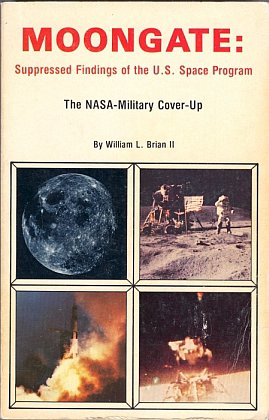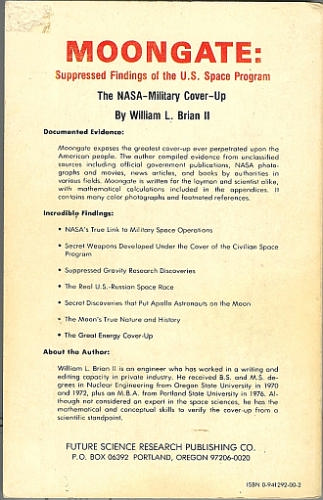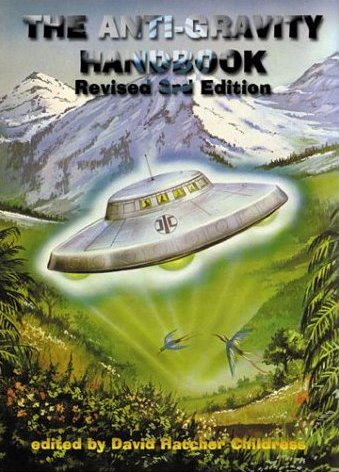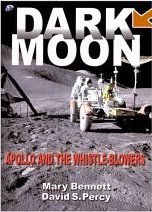|
The Neutral Point A point in space at which a particle experiences
no net gravitational force. In theory, a unique neutral point would exist
between any two static bodies. In practice, when two objects, such as Earth
and the Moon are orbiting each other, there are five points, known as Lagrangian
points, at which gravitational and centrifugal forces are exactly in balance.
|
||||
| "At a point 43,495 miles from the Moon, lunar gravity
exerted a force equal
to the gravity of the Earth, then some 200,000 miles distant." - Wernher von Braun (Time Magazine, July 25, 1969.) |
||||
| Subject: What is the Earth Moon neutral point?
Date: Wed Jun 10 16:59:36 1998
What is the gravitational neutral point between the Earth and the Moon? Is there empirical data from
Apollo?? I can calculate it with Newton's law of
Re: What is the Earth Moon neutral point?
The neutral point is defined as the point between the Earth and the Moon where the gravitational forces of the Moon exactly equal the gravitational forces of the Earth. Since they are pulling in opposite directions, this point is a point where something with no velocity will stay without falling to either the Earth of the Moon. It is also an important point in flights to the Moon because if the spacecraft reaches the neutral point with any forward velocity, it can then fall to the Moon without expending additional fuel for thrust. Knowing that the ratio of the masses of the Earth and Moon is approximately 81:1 and the gravitational forces vary inversely with the square of the distance, the approximate neutral point can be calculated. It turns out the neutral point is about nine times further from the Earth than the Moon or approximately 340,000 km (211266.20528)from the Earth. An accelerometer on the Apollo Command Module should have discerned the exact point where each spacecraft went through the neutral point on their journey to the Moon, but no explicit reference could be found to confirm this. Note that in the above paragraph the distance is given as an approximate value. Newton's work assumes point masses or objects that are perfectly spherical and have a uniform density. As a quick glance around the Earth and up into the sky can tell you, neither the Earth or the Moon are points or perfectly smooth spheres. Furthermore, the density of both bodies varies with the type of rock that predominates within a region. Also, the orbit of the Moon is not circular but elliptical. As the distance varies, the attractive forces acting upon a spacecraft also vary. Under those conditions the neutral point actually moves constantly around a mean value. Seemingly meaningless things such as the direction the Himalayas are pointing actually become important. A closely related concept are the Lagrangian or L points. Joseph-Louis Lagrange was a mathematician who lived between Jan. 1736 and April 1813. During this time a considerable amount of work was done on the orbits of the Moon and planets. One of the key concepts was the mathematical description of the motion of a three body problem, i.e., the Earth, the Moon and the Sun. His work showed that there are places 60° in front of and behind a planet in its orbit where the gravitational forces between the Sun and the planet cancel each other out. These became known as the Lagrangian or L points. While Lagrange did not believe these points had any special significance in the Solar System, astronomers have since discovered several asteroids in the Lagrangian points for the Earth and Jupiter. The ones for Jupiter are called the Trojan asteroids. Achilles was the first one discovered in 1908. The Lagrangian points also exist in the Earth-Moon system as well. They move about a central point as the Earth and Moon orbit one another and rotate on their axes. The Lagrangian points may become important in the future as they are excellent places to build communication satellites and potentially even space colonies. Several of the L5 Societies and related organizations can be accessed through the National Space Society. Reference: Concise Encyclopedia of Astronomy, Paul Muller, Follett Publishing, Chicago, (1968) pp. 166-167 |
||||
| APOLLO 8
The Second Mission: Testing the CSM in Lunar Orbit 21 December–27 December 1968 At 055:38:40 the crew were notified that they had become the first humans to travel to a place where the pull of Earth’s gravity was less than that of another body. The spacecraft was 176,250 n mi from Earth, 33,800 n mi from the Moon, and their velocity had slowed to 3,261 ft/sec. Gradually, as it moved farther into the Moon’s gravitational field, the spacecraft picked up speed. |
||||
| Public Affairs Officer - "This is Apollo Control, Houston at 55 hours, 38 minutes into the flight and we have been asked for a reaction here in the Control Center during that television passage. I think the remark from Lovell that got the most reaction was in his description of the blue and brown Earth and not being sure of whether he would land on it. This triggered a tremendous spike of laughter, the likes of which I can't recall, which immediately settled down to business. And in general, the room the - there was just zero talking going on in the room at the time, except for what we all heard from Mike Collins. In an exchange which the crew - And as we have been talking, the Apollo 8 has passed the - into the Moon's Sphere of Influence; and quite literally this is a historic landmark in space flight because, for the first time, a crew is literally out of this world. They are under the influence of another celestial body, the Moon, from which the Earth - 33,820 straight line nautical miles. We indicated earlier our space digital chart, at some point - not yet completely clear - will switch over and start giving us Moon-related values. That switch just took place and we immediately have configured. Velocity is now 3,989 feet per second in relation to the Moon and the last value, in relation to the Earth, was 3,261 feet per second in relation to the Earth. We'll see this number go down off the Moon related figure over the coming period. ...Apollo 8 ... now presently 33,681 [nautical] miles [62,377 km] from the Moon and moving in a Moon related velocity [of] 3,989 feet per second [1,216 m/s]. At 55 hours, 42 minutes into the mission, this is Apollo Control, Houston." | ||||
| A Skeptics View
The crux of the "Moongate" argument The book "Moongate: Suppressed findings of the U.S. Space program" by William L. Brian is centred on the position of the so called neutral point i.e. the point at which the gravitational pull of the moon equals the gravitational pull of the earth. During the fifties the neutral point was quoted as being approximately 24,000 miles from the Moon. In July 1969 Werner von Braun stated that the neutral point was 43,495 miles from the Moon. Brian claims that the neutral point distance has been used by NASA to cover-up the fact that the moon's gravity is greater than the one sixth of earths gravity. According to Brian if the neutral point is 43,495 miles from the Moon then the Moon's gravity would be 65% of that on Earth. David Thatcher Childress in his book "The Anti-Gravity Handbook" even suggests that if the gravity on the Moon is as large as Brian suggests, then NASA would have had to use ultra secret anti-gravity devices to carry out the moon landings. Captured alien technology, no doubt! The above points can be dismissed by anyone with a small amount of Physics. The graph below can be created on a spreadsheet with one formula. * g = gravity (metres/second^2)
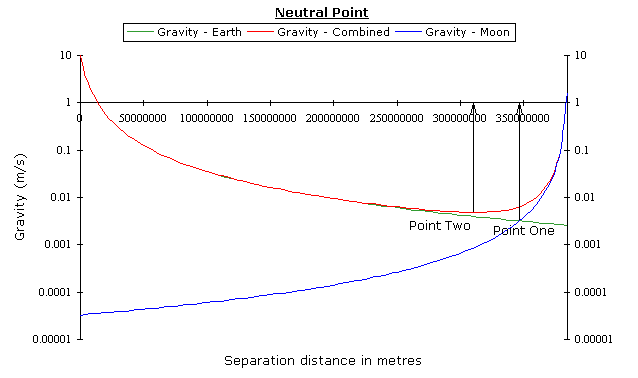 The green line represents the gravitational pull of the Earth and the blue line represents that of the Moon. They cross at a neutral point (Point One) approximately 37,500 kilometres (24,000 miles) from the Moon, precisely the early figure quoted by scientists. The red line however shows the Earth's and Moon's gravity acting together. As you can see this shifts the neutral point (Point Two) to 71,900 kilometres (43,000 miles) from the Moon. Therefore the graph shows that using the same values of g for the Earth and Moon we can get two very different answers for the location of the neutral point depending on the way you look at the results. Sorry guys, no cover-up and no anti-gravity devices! |
||||
|
Join the discussion here [i]Originally posted by SpaceMax[/i] Post ID3685935 Nomenclature is everything
fellas.
Thanks for the information SpaceMax. I prefer to use the quotes of those who were in the spacecraft, of which I have 2 and then I will quote others including von Braun. [ex]It was Saturday December 9 (1972), and we were in the Moon’s firm hold, only about 38,000 miles out and drawing closer by the moment. Eugene Cernan “The Last Man On the Moon” Copyright 1999 Eugene Cernan and Don Davis.[/ex] [ex]For the last fourteen hours we have been in the lunar sphere of influence, and our velocity has gradually picked up from a low of 3000 feet per second to its present 7600 feet per second. Four hours later we will attempt LOI, which should achieve a sixty-mile orbit. Michael Collins “Carry The Fire” Copyright 1974 by Michael Collins.[/ex] (3000 fps=2045+ mph x 18 hours = 37,000 miles) [ex]Soon after that a new stage in manned spaceflight was reached. Like a ball thrown upwards, the spacecraft had been gradually slowing down, until its velocity was 2724 mph and its position was 202,825 miles from Earth, and 38,900 miles from the Moon. For the first time, men had reached a point where the pull of Earth’s gravity was less than that of another body. Now the pull of lunar gravity was greater and the craft’s speed began to increase again as it fell towards the moon. Reginald Turnhill “The Moonlandings” Copyright Reginald Turnhill 2003.[/ex] [ex]"At a point 43,495 miles from the Moon, lunar gravity exerted a force equal to the gravity of the Earth, then some 200,000 miles distant." - Wernher von Braun (Time Magazine, July 25, 1969.)[/ex] The Bullialdus/Newton inverse/square law states that any physical quantity or strength is inversely proportional to the square of the distance between them, specifically, the gravitational attraction between two massive objects, in additional to being directly proportional to the product of their masses, is inversely proportional to the square of the distance between them. So knowing only the size of the 2 bodies, Earth and the Moon, and the neutral point we can determine the relative gravitational pull. No need to speculate about density. Therefore we can state that using the following parameters: Re = radius of the Earth = 3,960 miles Rm = radius of the Moon = 1,080 miles X = distance from the Earth’s center to the neutral Point = 200,000 miles Y = Distance from the Moon’s center to the neutral point = 43,495 miles Ge = Earth’s surface gravity Gm = Moons surface gravity Since the forces of attraction of the Earth and the Moon are equal at the neutral point, the inverse- square law yields: Ge (Re2/X2) = Gm(Rm2/Y2) Gm/Ge = Re2Y2/Rm2X2 = (3,960)2 (43,495)2
(1,080)2 (200,000)2
= .64 Therefore, Gm = .64 Ge So the gravity on the moon is approximately .64 that of earths gravity or almost two thirds. Now we understand why the Apollo astronauts were making those pitiful 6 inch hops on the moon. It should also be obvious why they tired so quickly. Hey, you want to argue 38,000 miles? It still comes out 55% of earth’s gravity. If the moon’s gravity was in fact, one-sixth that of earth or approximately 16.66% we could work the problem in reverse and come out with a neutral point from the moon of about 24,000 miles. If the Moon’s gravity is only one sixth Earth’s why did Apollo orbit at 60 to 70 miles? Why did the Lunar Orbiter series only [i] once [/i] get as low as 25 miles? That the gravity on the Moon is one sixth that of earths is one of the biggest con jobs in the history of mankind. Thanks for your help SpaceMax. : |
||||
|
(MGTE)--Page 32 "The point where a spacecraft enters the predominant attractive zone of the Moon's gravity is called the neutral point. It is the region in space where the Earth's force of attraction equals the Moon's force of attraction. Since the Moon is smaller and SUPPOSEDLY has a smaller surface gravity, the neutral point should be quite close to the Moon. In fact, if it is assumed that the Moon has one-sixth of the Earth's surface gravity (which is what we are all taught in school), the neutral point is calculated to be about nine-tenths of the distance between the Earth and the Moon. The average distance to the Moon is about 239,000 miles, hence this places the neutral point approximately 23,900 miles from the Moon's center." (MGTE)--Page 45 "At a point 43,495 miles from the Moon, lunar gravity exerted a force equal to the gravity of the Earth, then some 200,000 miles distant." ('Time' magazine, July 25, 1969.) (MGTE)--Page 45-46 "At a distance of 43,495 miles from the Moon, Apollo 11 passed the so-called 'neutral' point, beyond which the lunar gravitational field dominated that of Earth." ('History of Rocketry & Space'--1969.) (MGTE)--Page 48-49 "...since the Earth's pull equals the Moon's
at the neutral point, the inverse-square law enables the pull of gravity
at the Moon's surface to be determined...The result is that the Moon's
surface gravity is 64% of the
(MGTE)--Page 61 "In one-sixth gravity everything would weigh
one-sixth, or 16.7%, of its Earth weight. A 180lb. man would
weigh a mere 30lbs. Writers were speculating on the athletic abilities
of men on the Moon long before the
(MGTE)--Page 63 "...even with the astronaut gear, (spacesuit, etc.)...(Apollo astronaut John Young)...should have been able to jump over six feet off the ground if the Moon had one-sixth of the Earth's gravity. In actuality, his efforts lifted him at most 18" off the ground. ...observations (of the NASA video tapes, and television broadcasts) indicated that Young made several attempts to jump as high as he could but with no success in achieveing a height of more than 18 inches." (MGTE)--Page 67 "A photo appeared in the December 12, 1969 issue
of 'Life' magazine showing Apollo astronaut Alan Bean carrying a barbell-shaped
package of instruments which allegedly weighed 190 Earth pounds.
The accompanying statement that it had a Moon weight of only 30 pounds
does not seem consistent with the photo
"The movie film of this event is even more revealing.
As Bean carried the instrument package across the lunar surface, the bar
bent up and down, strained by the heavy burden on each end. It was
also
apparent that the
(MGTE)--Page 68 "Astronauts were sent to the Bend, Oregon area to get their 'Moon Legs.' Walter Cunningham was the first to try out the Moon suit, backpack life support system, and certain tools to be used by Armstrong and Aldrin on the Moon excursion." "That the astronauts were able to maneuver around at all in the Bend, Oregon area with their gear on suggests that the gear weighed far less than 185 pounds. (The weight that we were all given.)" (MGTE)--Page 72-73 "When Apollo 14 astronauts were in view of the south flank of Cone Crater, Shephard went down on one knee to pick up a rock and required the aid of Mitchell to stand up. About 2/3 of the way to their destination, their heart rates were up to 120 beats per minute as they moved uphill." "As they climbed, Shephard's rate reached 150 per minute and Mitchell's went to 128." "The astronauts never reached Cone Crater. They went back down hill toward Weird Crater to collect rock samples, then on to triplet to dig trenches." (MGTE)--Page 74 "The author observed one of the Apollo 14 astronauts in a movie film of the mission. The astronaut was running in semislow-motion in an otherwise perfectly normal manner. The discrepancy arises when it i considered that the astronaut went no higher off the surface and went no farther with each step than he would have on Earth. The slow-motion effects could not cover up this fact. This suggests that the film speed was adjusted to slow down the action to give the impression that the astronauts were lighter than they actually were. With the slow-motion effects, objects would appear to fall more slowly and the public would be convinced of the Moon's weak gravity." (MGTE)--Page 75 "The Rover was supposedly designed for the Moon's one-sixth gravity, but close examination indicates that it resembled a vehicle more suitable for near-Earth gravity. It was approximately 10 feet long and 4 feet high, with a 7.5 foot wheelbase and 6 foot tread width. The wheels were 32" in diameter with chevron-shaped treads of Titanium, not much different looking than an Earth tire." (MGTE)--Page 76-77 "...a minimum-size vehicle (for use on the Moon) would need a wheelbase of 20 feet to give it speed capability over rough terrain...To keep the center of gravity to within 6 feet of the surface, it would need a tread width of 20 feet" (MGTE)--Page 77 "The Rover encountered mostly loose dust and
rocks on the Moon. This type of surface would have less traction
than ordinary pavement. The Rover had a loaded Earth weight of 1,540
lbs. Under one-sixth gravity, only 128 lbs. of force would
be required to make the vehicle slide. Therefore, in going the maximum
speed of 10.2 MPH, the vehicle would begin to slide if the wheels were
turned enough to make a radius of curvature of less than 84 feet.
Even at 5 MPH, the minimum curvature would be 20 feet. The operator
would have to
(MGTE)--Page 79-80 "Charles Duke (Apollo 16) evidently had a difficult
time on the Moon. He fell a number of times and a series of photos
appeared in many newspapers which showed him stumbling and falling...Since
objects would take nearly 2-1/2 times longer to fall in one-sixth gravity,
Duke should have had plenty of time to catch himself. It is even
more surprising that Duke fell as OFTEN as he did considering that he was
wearing the most advanced, updated Moon suit which supposedly provided
him more flexibility than any astronaut before him."
|
||||
by David Thatcher Childress
"Dark
Moon: Apollo and the Whistle-Blowers"
|
||||
| Moon Neutral Point
http://www.bautforum.com/archive/index.php/t-37153.html jrkeller
JayUtah
But in practical navigation Point Two can be used as a rough approximation for when to switch your navigation reference from your origin to your destination. After your spacecraft has come within 44,000 miles of the moon you can consider your trajectory as a moon-fixed path with perturbations from Earth, whereas before it was an Earth-fixed or space-fixed trajectory with perturbations from the moon. JayUtah
BTW, for a more orbitally mechanical description of the Earth-moon "neutral point" consult Bate's Fundamentals of Astrodynamics, chapters 7 and 8. Fig. 7.4-1 gives a much better graphical notion of crossing over into the moon's sphere of influence. montebianco
My question is, what is Point Two used for? Or is it just something that pops out of the equations. Point two looks completely meaningless to me. If I'm interpreting the graph and text correctly, it is the point where the sum of the force of the earth's gravity and the moon's gravity is at a minimum. One slight problem - they pull in opposite directions. To add two forces which pull in opposite directions simply by adding their magnitudes is not meaningful; the correct way to combine them is to subtract the one from the other. Quite apart from the issue others have pointed out (that a spacecraft wouldn't just travel along a straight line from the earth to the moon), this "addition" of forces is just wrong... JayUtah
I apologize for the poor quality of the reproduction; I don't seem to have a scanner and Bate at the same location. The only meaningful "neutral point" from the point of view of how this type of transfer trajectory is designed is the point at which the curving trajectory meets the circle that represents the moon's sphere of influence. Now granted this is but one possible formulation of "neutral point", but as has been laboriously and correctly pointed out, Brian's formulation is as useless as it can possibly be for actual physics. Now it is worth pointing out that Brian (apparently) correctly notes that NASA provided two different values for the "neutral point". He is at least correct on the face of the argument for asking about the inconsistency. However to assume that the 44,000 mile figure was derived from the linear, static method, and thus to "plug" that value back into it and derive the necessary mass of the moon is entirely wrong. Bate gives the radius of the lunar sphere of influence as 66,300 km or 41,400 miles. The short line extending from the moon to the point at which the trajectory intercepts the circle around the moon is that radius, and it's easy to see that the point does not lie on a line between Earth and moon. The linear approach is clearly wrong, but the static approach is also wrong too. Regardless of how one draws the vectors, we have to keep in mind that the Earth and moon are not stationary objects. In order to place an object between Earth and moon so that all the applicable vector quantities balance, you need Lagrangian mathematics and therefore the location of the Earth-moon L1 or L2 points. Ironically the distance from the moon to L1 does not equal the distance to L2. There are simply too many ways to consider the idea of "neutral point" to make Brian's conclusions sound. |
||||
| List of Neutral Point figures |

